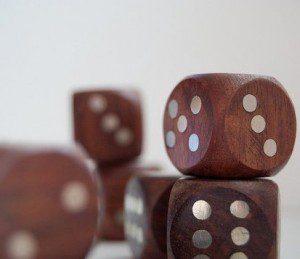Law of Small Numbers Definition
 The law of small numbers refers to the incorrect belief held by experts and laypeople alike that small samples ought to resemble the population from which they are drawn. Although this is true of large samples, it isn’t for small ones. So the “law” of small numbers isn’t really a law at all, but a fallacy. And as such, it is a law you should feel free to break.
The law of small numbers refers to the incorrect belief held by experts and laypeople alike that small samples ought to resemble the population from which they are drawn. Although this is true of large samples, it isn’t for small ones. So the “law” of small numbers isn’t really a law at all, but a fallacy. And as such, it is a law you should feel free to break.
Law of Small Numbers Analysis
To provide an example, suppose you have an urn containing marbles—half of them red and half of them blue (statisticians love urns…especially ones with marbles in them). Suppose further that without looking, you draw 100 of them. What are the odds that about half of them will be blue? Although it is unlikely that exactly half will be blue (i.e., you probably won’t draw exactly 50 blue marbles), the odds are good that it will be close with a sample of 100. With 1,000, the odds are even better—and they keep getting better until your sample reaches infinity (a fact known as the law of large numbers).
But suppose instead you draw a smaller sample, say, only two marbles. There, the odds of half of them being blue is much lower…only 50%, to be exact. And with a sample of only one, the odds drop to zero. So whereas large samples tend to resemble the population from which they are drawn, smaller samples do not.
The problem is that for most of us, this fact is counterintuitive. People tend to expect small samples to behave just like large ones, a fallacy that leads to all sorts of errors in everyday judgment and decision making.
For instance, when people are asked to mentally generate a sequence of “random” coin tosses, their sequences tend to be anything but. That is, people expect there to be many more alternations than would be expected by chance. In other words, they expect not only the entire sequence to contain approximately 50% heads, but each portion of the sequence to contain approximately 50% heads as well.
The same is true in the world of sports. When people observe a basketball player make several baskets in a row, they assume it must because he or she is “hot.” They forget that because the sample size is small, such coincidences are not only unsurprising, they are inevitable. In fact, when a group of scientists examined the shooting pattern of professional players, they found something remarkable—there is no such thing as the “hot hand” in basketball. That is, players are no more likely to make a shot after making the previous shot (or shots) than after missing the previous shot (or shots). Despite this fact, people continue to believe in the hot hand, one of several by-products of the mistaken belief in the law of small numbers.
References:
- Gilovich, T. (1991). How we know what isn’t so: The fallibility of human reason in everyday life. New York: Free Press.
- Tversky, A., & Kahneman, D. (1971). Belief in the law of small numbers. Psychological Bulletin, 76, 105-110.